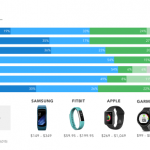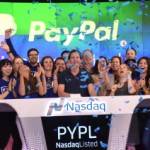These Are The Top 5 Workplace Trends We’ll See In 2017
This was a “remarkable” year for hiring, according to Glassdoor’s chief economist, Andrew Chamberlain. He says that the U.S. added an average 180,000 new jobs per month, well above the “break even” pace of job growth of 50,000 to 110,000 economists estimate the economy needs to keep Americans fully employed.
Pay is also on the rise. Median base pay for U.S. workers was up 3.1% from 2015, the fastest pace in three years. Can we top all that in 2017?
According to Glassdoor’s newest report on job trends, there are also a record number of unfilled jobs—5.85 million as of April—which represents the most since the BLS started tracking job openings in 2000. That’s compounded with the fact that every employer is hiring for tech roles, Chamberlain observes, and there are just so many talented candidates out there.
2017 Job Trend #1: HR Will Transform Itself
Which is why he’s predicting that 2017 is going to be the year human resources transforms itself into “people science.”
Chamberlain argues that the rise of big data has infiltrated and transformed everything from product design to finance. As businesses generate more data from their employees and customers, good analysis of that data can lead to smarter decisions, shorter project time lines, and happier consumers.
Unfortunately, HR and recruiting have been largely absent from this evolution, says Chamberlain. Data scientists, one of the most in-demand positions for the past two years, haven’t been much of a presence in HR-related tasks. But as Chamberlain points out, “Using data science in HR to make even small improvements in recruiting, hiring, and engagement has the potential for huge benefits to organizations.”
A good place for HR to start is by tapping into workforce analytics that can track every stage of an employee’s progression through a company from on-boarding, through training and promotions. These are available at low cost through a number of third party providers.
Another solution is to use a sentiment tracker to gather feedback in real time. Amanda Moskowitz, founder of the startup leadership sharing resource Stacklist, told Fast Company in a interview[/url] that founders of companies that don’t have formal HR departments are using tools like Glint and Small Improvements. Other available tools include platforms for A/B testing to experiment with different methods of workforce management. Chamberlain points out “there are many low-hanging fruit today for better data science in HR” and they don’t cost much.
2017 Job Trend #2: Many Things Get Automated But We Don’t Lose Our Jobs
There’s a lot of talk about automation and how much its advancement will make human workers obsolete. Chamberlain cites research from the Journal of Economic Perspectives that indicate mass layoffs due to automation are unlikely. This correlates with findings from the McKinsey Global Institute (MGI) on the potential for automation across 54 countries and more than 2,000 work activities. The report found that the number of jobs that can be fully automated by adapting currently demonstrated technology is less than 5%. That number could go as high as 20% in some middle skill categories.
Says Chamberlain: “The jobs that will be most affected by automation are routine jobs that need to be done the same way and that don’t require much flexibility or much creative judgment.” As such MGI found that about 60% of all jobs have a least a third of activities that could be automated based on current technology such as answering email or scheduling meetings. “Workers increasingly need to build skills that are complementary to technology—learning to run the machine, not doing the same work the machine automates,” Chamberlain observes.
2017 Job Trend #3: Nontraditional Benefits Will Become Less Popular
From assistance with paying back student loans to unlimited food and beverages, the benefits packages at many companies have altered the standard health insurance and 401(k) matches. However, Chamberlain sees a move away from the more exotic perks and benefits.
That’s because Glassdoor’s research revealed that perks such as gym memberships, charitable giving, and other nontraditional offerings don’t boost employee satisfaction as much as health insurance, 401(k) matches, and paid time off. If the goal of the compensation package (including both pay and benefits), says Chamberlain, is to “serve as a targeted investment, delivering great employee engagement, and keeping talent on board long term,” then companies should be rethinking their offerings in 2017.
2017 Job Trend #4: We’ll Make Progress Narrowing The Wage Gap
Chamberlain believes this is the year the gap will narrow because we’re at a tipping point. More data is available than ever, transparency is a core value for many companies, and business leaders are recognizing that equal pay isn’t just a compliance issue, it’s a necessity to retain talent.
Sixty seven percent of U.S. employees said they were not likely to apply for a job at a company where men and women were paid unequally for the same work, according to Glassdoor’s research. Expect to see wider adoption of building analysis into companies’ pay practices in the coming year, says Chamberlain.
2017 Job Trend #5: The Gig Economy Will Slow Down
Chamberlain expects the growth in the gig economy will taper off in 2017. He offers three reasons for the slowdown.
Despite the visibility of Uber, Lyft, Airbnb, Task Rabbit and others, their impact is still quite small. A J.P. Morgan Chase Institute study found only about 4.3% of U.S. adults had ever earned income from an online “gig” platform as of June 2016, a figure that’s been declining over the last three years. Another study from the EPI made a similar discovery, that the freelance economy isn’t growing as much as we think. Gig work is inherently based on demand, and in times of less demand, those gigs dry up, further gutting potential growth.
Another limit to growth is that gigs by nature have to be simple and discrete projects or transactions. As Chamberlain notes,
“The fastest growing jobs today are ones that require human creativity, flexibility, judgment, and ‘soft skills.’ That list includes health care professionals, data scientists, sales leaders, strategy consultants, and product managers. Those are exactly the kind of jobs least likely to function well in a gig economy platform.”
Therefore he says, it’s not likely that you’ll be able to get legal, financial, medical, engineering, or other services through a gig platform in 2017 and beyond.
It’s a great time for both employers and workers to set themselves up to take advantage of the opportunities represented by these trends, says Chamberlain, so “Invest in skills and technology now while times are good.”
Fast Company , Read Full Story
(30)














